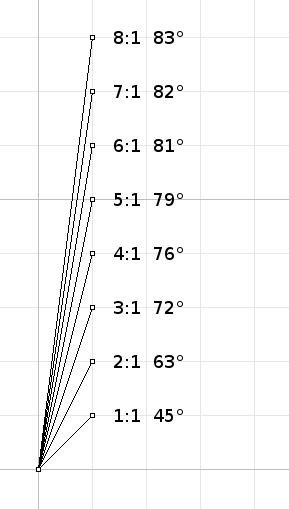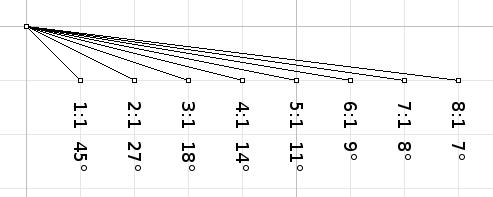This article explores L/D (lift/drag). L/D is one of the most important quantitative aspects of kite performance.
Insight
The lift drag ratio of a kite can be measured from the angle of the kite line. See the graph below:

Notice anything interesting about the values in relation to the graph? Yes, that's right, the L/D value for an angle can be directly read by the Y/X slope of the line!
Some sources indicate that tan(angle) is direct way to calculate L/D from the vertical line angle. For example: a kite is flying at 71.6°. The calculation tan(71.6) gives: 3.0, i.e. a 3:1 L/D ratio.
This is correct in the same way that computer helpdesk solutions are correct: they answer the question, but give no insight into the nature of the phenomenon. :-)
Here's the key: think of L/D as the measurement of how many units of lift are produced for each unit of drag. In this way, the graph above makes sense: a 5:1 lift/drag ratio in the picture above has 5 units of lift (Y axis) for each one unit of drag (X axis).
Extremes
As L/D increases, there is less and less difference between line angles for incremental improvements in L/D. As shown in the graph above, the angle change (8°) between 2:1 and 3:1 is less than half the angle change (18°) between 1:1 and 2:1.In my opinion, L/D values above 8:1 (83°) become very difficult to determine accurately by line angle measurement.
Alternatives
Vertical line angle is not the only way to determine L/D.Anders Ansar has a page where he explains: "The L/D of the kite is equal to the speed of the kite divided by the actual wind speed. Or if you like, the L/D says how many times faster than the wind the kite is capable of traveling."
This is an interesting insight, and backs up what we know intuitively: a high performance kite is both fast and has a large wind window. These two features are just facets of the same attribute: high L/D.
This same page describes Dave Culp's suggestion: fly a kite horizontally from a moving car and measure the angle in relation to the direction of travel.
Another measurement strategy is to turn a kite into a glider. Videos of a NPW rigged as a glider can be seen in Jou Jelle's report (in Dutch). Talk about full circle: a device designed as a recovery glide parachute is used as a hobbyist kite. The kite is then used as a gliding chute!
There is a direct correspondence between glide angle of a glider and line angle of a kite. Both indicate L/D. The graphic above, rotated 90° could be used just as well for calculating the L/D of a glider based on glide angle.

Interestingly, the weight of the glider does not affect maximum achievable L/D. Tony Verhulst describes this in the article: Effects of Water Ballast. For the same L/D, heavier gliders go faster.
The correspondence between gliders and kites can be shown in this area also. Gliders become faster with more weight, but the L/D does not change. In the same way, wind speed does not change the L/D of a kite, but the tension in the line increases (up to the point where your feet leave the ground!)
This L/D independence of weight and windspeed is ceteris paribus. ("all other things being equal", don't you love Latin phrases!) There will be additional stresses on the kite causing skin shape to vary with windspeed. This will lead to changes in L/D seen during changes in windspeed.
The weight of the kite becomes a significant factor in L/D as windspeed drops. The force of gravity acts on the kite and line to change the flying angle. A heavy foil might outfly a single skin kite in high winds, but fall out of the sky when windspeed drops, leaving the single skin to claim higher performance in low wind conditions. Weight, being a fixed value, has decreasing influence on L/D as windspeed increases.
Reset
Most kite fliers (myself included!) are overly generous when estimating the angle at which a kite is flying. Here is a method to mentally 'reset' your picture of 90°:Find a tall building in your area. Goto a part of the building which has an overhang so that you are standing directly under the vertical face. With your back to the building, start tilting your head up until you see the edge of the face of the building.
That's 90°! Now, has your kite ever *really* flown at this angle? ;-)
Improving L/D
Peter Lynn tells us how to improve L/D in his newsletter article The Six Aerodynamic Myths of Kite Traction.
That the upwind performance (that is, lift/drag ratio) of kites is primarily a function of profile and aspect ratio. Wrong. The strongest determinant of L/D is angle of attack. Low angles of attack yield high L/D in an inverse relationship, profile and aspect ratio have comparatively little effect."
Finding ways to improve L/D primarily means finding ways to operate a kite at low angles of attack.
Summary
There is a direct relationship between L/D and the angle at which a kite flys. Think intuitively about L/D as graphing a result: units of lift (Y axis) per units of drag (X axis). Angle of attack has the most influence on L/D.